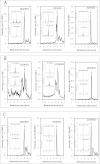Detection of novel CYP11A1-derived secosteroids in the human epidermis and serum and pig adrenal gland
- PMID: 26445902
- PMCID: PMC4597207
- DOI: 10.1038/srep14875
Detection of novel CYP11A1-derived secosteroids in the human epidermis and serum and pig adrenal gland
Abstract
To investigate whether novel pathways of vitamin D3 (D3) and 7-dehydrocholesterol (7DHC) metabolism initiated by CYP11A1 and previously characterized in vitro, occur in vivo, we analyzed samples of human serum and epidermis, and pig adrenals for the presence of intermediates and products of these pathways. We extracted human epidermis from 13 individuals and sera from 13 individuals and analyzed them by LC/qTOF-MS alongside the corresponding standards. Pig adrenal glands were also analyzed for these steroids and secosteroids. Epidermal, serum and adrenal samples showed the presence of D3 hydroxy-derivatives corresponding to 20(OH)D3, 22(OH)D3, 25(OH)D3, 1,25(OH)2D3, 20,22(OH)2D3, 20,23(OH)2D3, 20,24(OH)2D3, 20,25(OH)2D3, 20,26(OH)2D3, 1,20,23(OH)3D3 and 17,20,23(OH)3D3, plus 1,20(OH)2D3 which was detectable only in the epidermis. Serum concentrations of 20(OH)D3 and 22(OH)D3 were only 30- and 15-fold lower than 25(OH)D3, respectively, and at levels above those required for biological activity as measured in vitro. We also detected 1,20,24(OH)3D3, 1,20,25(OH)3D3 and 1,20,26(OH)3D3 in the adrenals. Products of CYP11A1 action on 7DHC, namely 22(OH)7DHC, 20,22(OH)27DHC and 7-dehydropregnenolone were also detected in serum, epidermis and the adrenal. Thus, we have detected novel CYP11A1-derived secosteroids in the skin, serum and adrenal gland and based on their concentrations and biological activity suggest that they act as hormones in vivo.
Conflict of interest statement
The authors declare no competing financial interests.
Figures





References
Publication types
MeSH terms
Substances
Grants and funding
- R21 AR063242/AR/NIAMS NIH HHS/United States
- R21 AR066505/AR/NIAMS NIH HHS/United States
- 1S10OD010678-01/OD/NIH HHS/United States
- 1S10RR026377-01/RR/NCRR NIH HHS/United States
- R01 AR056666/AR/NIAMS NIH HHS/United States
- R01 AR052190/AR/NIAMS NIH HHS/United States
- 1R01AR056666-01A2/AR/NIAMS NIH HHS/United States
- 1R21AR0666505-01A1/AR/NIAMS NIH HHS/United States
- 2R01AR052190-A6/AR/NIAMS NIH HHS/United States
- S10 OD010678/OD/NIH HHS/United States
- S10 RR026377/RR/NCRR NIH HHS/United States
- 1R21AR063242-01A1/AR/NIAMS NIH HHS/United States
LinkOut - more resources
Full Text Sources
Other Literature Sources

